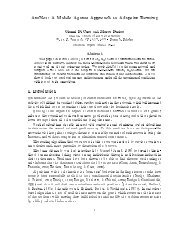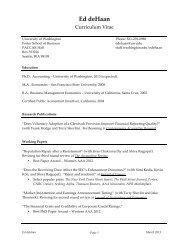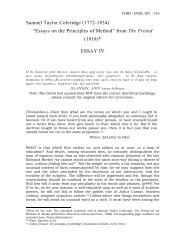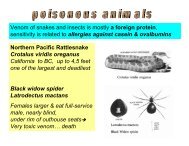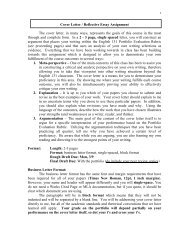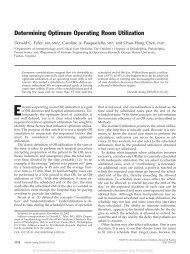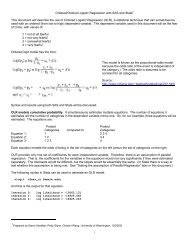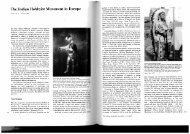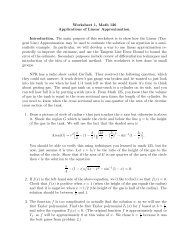Spices and perfumes – driving forces of humans
Spices and perfumes – driving forces of humans
Spices and perfumes – driving forces of humans
Create successful ePaper yourself
Turn your PDF publications into a flip-book with our unique Google optimized e-Paper software.
<strong>Spices</strong> <strong>and</strong> <strong>perfumes</strong> <strong>–</strong> <strong>driving</strong> <strong>forces</strong> <strong>of</strong> <strong>humans</strong><br />
In ancient Near Eastern cultures fragrances <strong>and</strong> spices were used to<br />
preserve meat, which later included human corpses mummification<br />
Egyptian girls used fragrant perfume cones (animal grease) for a sure shortdistance<br />
effect on the Old Egyptian male. Together with the dress it devastated.
Discovery <strong>of</strong> resins as preservatives <strong>of</strong> meat<br />
(volatiles + solids in some resins repel insects, fungi,<br />
bacteria) leads Egyptian priests (!!!) to invent<br />
….mummification?? Highly pr<strong>of</strong>itable, blame it on<br />
Anubis!
<strong>Spices</strong><strong>–</strong> one <strong>of</strong> the secret <strong>driving</strong> <strong>forces</strong> <strong>of</strong> history<br />
Pliny complained that Romans spent too much gold on spices. Modern people<br />
use 1 kg spice per year. Geopolitical events like the Mongol expansion into<br />
China & Arabia interrupted the old trade routes <strong>and</strong> started a rediscovery <strong>of</strong> the<br />
world by the European powers. See routes to India, China, Japan, America,<br />
Australia <strong>and</strong> Antarctica,<br />
408 the Visigoths under<br />
Alaric I for the first time in<br />
almost 800 years laid<br />
siege to Rome. The<br />
Senate negotiated a deal<br />
5,000 pounds <strong>of</strong> gold,<br />
30,000 pounds <strong>of</strong> silver,<br />
& 100 sacs <strong>of</strong> pepper
<strong>Spices</strong> = plants <strong>of</strong> the gods but desired by <strong>humans</strong><br />
crucial factor in history <strong>of</strong> colonization<br />
3000 BC Assyrian (Nineveh) clay tablets mention sesame wine &<br />
philosophy: evil things smell bad (devil smells <strong>of</strong> sulfur!), sweet smells<br />
signify purity fumigation <strong>of</strong> spice to clean the air for gods + <strong>humans</strong><br />
2000BC EGYPT: in Harris papyrus spices are the plants <strong>of</strong> the gods!<br />
In Ebers papyrus 1552 BC : cori<strong>and</strong>er, caraway, sesame, saffron, onions<br />
Spice trade was accomplished first by the<br />
Phoenicians, than massively by Romans by<br />
ship trough Alex<strong>and</strong>ria <strong>and</strong> snail mail via<br />
silk road, Persia; had access to Indian &<br />
Chinese spices, replaced by Venice<br />
May 21 st 1498 Vasco da Gama reached Calicut (Calcutta), Venice out<br />
Columbus tried reach India going westwards, found pepper isl<strong>and</strong> Cuba<br />
1595 Van Houtman reached Sumatra, Madagascar, Borneo<br />
1780 spice war between Holl<strong>and</strong> & Engl<strong>and</strong> ceased Ceylon, India
<strong>Spices</strong> like all herbs have mythical lore<br />
2500 BC Egyptian expedition to l<strong>and</strong> <strong>of</strong> Punt acquired spices & incense<br />
950 BC visit <strong>of</strong> Queen <strong>of</strong> Sheba (Ethiopia) to Solomon (Israel) was to<br />
encourage spice trade<br />
500 BC Greeks grew caraway, cardamom, anise, mustard, fennel. Import<br />
pepper,cinnamon, ginger from China via silk road or Phoenician sailors:<br />
“cinnamon grows in African swamps guarded by bat-like vampires”<br />
0-1700 AC Arabs dominate spice trade “ cinnamon is gathered from the<br />
nest <strong>of</strong> gigantic birds that need to be fed donkey meat to get to it.”<br />
6. Pigeons were fed<br />
caraway seeds to secure<br />
their return<br />
Warming quality qualified spices to be<br />
suspected aphrodisiacs:<br />
1. Chewing caraway seeds makes attractive<br />
2. aniseed, cinnamon, nutmeg, mace, & ginger<br />
3. Cori<strong>and</strong>er seed & dill seed drunk together<br />
4. Cumin, dill & salt carried by German brides .<br />
. during wedding guaranteed their faithfulness<br />
5. Indian brides painted with turmeric for luck
<strong>Spices</strong> are defense compounds turned from weapons to pleasure<br />
<strong>Spices</strong> are plant-derived combinations <strong>of</strong> substances that in their<br />
pure form <strong>and</strong> concentration are potent insect <strong>and</strong> herbivore<br />
repellents:<br />
Chew on a leaf <strong>of</strong> bay or oregano, a clove or a peppercorn <strong>and</strong> even<br />
a vanilla fruit <strong>and</strong> you will realize it.<br />
Humans have two options insects do not have!<br />
1.Dilute the repellants (toxicity is matter <strong>of</strong><br />
concentration; Paracelsus)<br />
2.Mix with ingredients that neutralize their repellent<br />
action.<br />
Aromatic volatiles will repel without contact (superior) while others<br />
like mustard oils (cabbages), sulfur compounds <strong>of</strong> Allium <strong>and</strong><br />
others activate only after the herbivore has bitten.
What are spices?
Families <strong>of</strong> good spices<br />
<strong>Spices</strong> are a cultural achievement <strong>of</strong> <strong>humans</strong> like music,<br />
dance <strong>and</strong> writing. Drive for spices was the memory <strong>of</strong> diversity<br />
tasted as gatherers before the monotony <strong>of</strong> crop feeding.
Silphion <strong>–</strong>extinct aphrodisiac & spice<br />
The Town <strong>of</strong> Cyrene in the N African<br />
province <strong>of</strong> Cyrenaica obtained its wealth<br />
from selling this tall member <strong>of</strong> the<br />
Apiaeceae , now extinct & perhaps related<br />
to recent Ferula asa-foetida (Persia,<br />
Afgh.) <strong>–</strong> the stinking asant or the devil’s dirt<br />
Cut in upper part <strong>of</strong><br />
perennial root releases<br />
latex that concentrates in 3<br />
days to resin-like lumps.<br />
These are used as spicy<br />
food add., aphrodisiacs &<br />
also was pop.<br />
contraceptive<br />
The shape <strong>of</strong> the<br />
silphion seeds was<br />
like shown on this<br />
ancient coin.<br />
Surprisingly, we do<br />
not find anything like<br />
that in nature, but in<br />
the ancient myths <strong>–</strong> a<br />
symbol <strong>of</strong> the heart
<strong>Spices</strong>: Sylphium<br />
Movie “Dune: “He who has the spice, rules the universe!”<br />
645 BC Greeks founded city Cyrene on the North<br />
African coast that was in reach <strong>of</strong> silphium country<br />
Theophrastus “ Study <strong>of</strong> Plants” described this plant’s anatomy, use,<br />
harvest etc as rather similar to today’s Ferula assa-foetida, a variant <strong>of</strong><br />
the giant fennel. Resin collectors tapped the thick root, added flour that<br />
causes it to reddish color <strong>and</strong> be stable when shipped to Athens in<br />
barrels. This plant was truly a wild plant since it avoided cultivated l<strong>and</strong>.<br />
Uses: 1. As a spice together with roasted meat or boiled pork belly<br />
marinated in cumin, silphium <strong>and</strong> sharp vinegar. Also Italian Greeks<br />
liked salted tuna with cheese <strong>and</strong> silphium sprinkled over it (pizza?)<br />
Roman Pliny described the end <strong>of</strong> Silphium: L<strong>and</strong> was overgrazed by sheep &<br />
last remaining Silphium plant sent to Emperor Nero. The Sahara exp<strong>and</strong>ed ….<br />
Alex<strong>and</strong>er the Great had discovered a silphium-like plant in the Hindu Kush<br />
mountains <strong>of</strong> Afghanistan: Ferula assa-foetida, not the same
Asafoetida <strong>–</strong> the ersatz Silphium <strong>of</strong> Greek antiquity<br />
Asafoetida = Europe’s forgotten spice?<br />
from Iran <strong>–</strong> a repulsively smelling resin<br />
from the Iranian Fennel Ferula asafoetida<br />
<strong>of</strong>ten adulterated with F. persica<br />
& F. galbanum <strong>–</strong> all tall stout umbellifers<br />
The secret <strong>of</strong> it was first discovered by<br />
German botanist Engelbert Kaempfer<br />
who travelled in Iran & Turkey under<br />
cover <strong>and</strong> wrote 1712 “Five studies <strong>of</strong><br />
exotic wonders, political,<br />
scientific <strong>and</strong> medical”
<strong>Spices</strong> have health effects like herbs
<strong>Spices</strong> acting like herbs: Cayenne pepper<br />
A few cloves steeped in boiling water remedy nausea & vomiting<br />
Cayenne is a vasodilator (causes blood vessels to open) &<br />
rubefacient. Common powder from a grocery store shaker<br />
can thus cause near instant warming <strong>of</strong> the h<strong>and</strong>s & feet on<br />
cold days or in people with reduced circulation.<br />
Cayenne contains a pungent resin-like substance<br />
known as capsaicin <strong>–</strong>which is active ingredient <strong>of</strong><br />
pepper spray, Irony: relieves pain <strong>and</strong> itching by<br />
neurotransmitter release & depletion. Without the<br />
neurotransmitters, pain signals can no longer be sent.
<strong>Spices</strong> acting like herbs; warm is just a feeling<br />
Cayenne is a vasodilator (causes blood<br />
vessels to open) & rubefacient. Common<br />
powder from a grocery store shaker can thus<br />
cause instant warming <strong>of</strong> the h<strong>and</strong>s & feet on<br />
cold days & in people with reduced circulation<br />
The niacin flush is a sign <strong>of</strong> vasodilation that you<br />
can experience easily. It is harmless but <strong>of</strong>ten severe<br />
enough that people stop taking the vitamin. Niacin<br />
opens blood vessels wider. People with high<br />
cholesterol levels can lower them with niacin.<br />
Cayenne contains a pungent resin-like<br />
substance known as capsaicin <strong>–</strong>which is active<br />
ingredient <strong>of</strong> pepper spray, Irony: relieves<br />
pain <strong>and</strong> itching by neurotransmitter release &<br />
depletion. Without the neurotransmitters, pain<br />
signals can no longer be sent.
Are you a masochist?<br />
Bitterness is one <strong>of</strong> the most crushing problems in a person’s<br />
life. Alternatively, it is a taste that is acrid or unpleasant.
Niacin <strong>–</strong> how to fake blushing<br />
Niacin is B-3, one <strong>of</strong> the water-soluble Bcomplex<br />
vitamins<br />
Dilates blood vessels creating sensation <strong>of</strong><br />
warmth <strong>and</strong> redness <strong>of</strong> skin as in “face flushing”<br />
do not exceed 25 mg/ session<br />
helps you to naturally relax & induce sleep.<br />
reduces harmful cholesterol levels in the blood<br />
reduces anxiety <strong>and</strong> depression<br />
A rubefacient is a substance for that produces redness <strong>of</strong> the skin e.g. by<br />
causing dilation <strong>of</strong> the capillaries <strong>and</strong> an increase in blood circulation.<br />
Common medicinal rubefacients include: Capsaicin (derived from Cayenne,<br />
Capsicum minimum), Salicylates (such as Oil <strong>of</strong> Wintergreen, Methyl Salicylate),<br />
Nicotinate esters = Niacin , Rubbing alcohol<br />
Common herbal rubefacients include: Cloves (Eugenia caryphyllus), Garlic (Allium<br />
sativum), Horseradish (Cochlearia armoracia), Mustard (Brassica alba or B. nigra),<br />
Ginger (Zingiber <strong>of</strong>ficinale),Nettle (Urtica dioica), Rosemary Oil (Rosmarinus<br />
<strong>of</strong>ficinalis),Rue (Ruta graveolens)
Piper nigrum<br />
<strong>Spices</strong> acting like herbs<br />
Black Pepper corns are<br />
dried fruits, white pepper<br />
corns are clean seeds<br />
piperine<br />
pungency <strong>of</strong> capsaicin <strong>and</strong> piperine is caused by activation <strong>of</strong> heat <strong>and</strong><br />
acidity sensing TRPV ion channel TRPV1 on nociceptors (pain sensing<br />
nerve cells).<br />
Piperine inhibits metabolism & transport <strong>of</strong> various drugs & so<br />
increases the bioavailability <strong>of</strong> other compounds like curcumin by<br />
2000% in <strong>humans</strong>. Also forVit B, which is important for older<br />
people having restricted uptake <strong>of</strong> it. “Old people! Spice it up.”
Curcuma longa<br />
Ginger family<br />
<strong>Spices</strong> acting like each others company<br />
cucurmine<br />
Cucurmin is the principal component <strong>of</strong> the Indian<br />
curry spice + yellow mustard powders. It is a<br />
polyphenol giving yellow color to the turmeric<br />
rhizome. With boric acid it gives a characteristic<br />
red color indicating the formation <strong>of</strong> rosocyanine.<br />
Curcumin acts as a free radical scavenger <strong>and</strong><br />
antioxidant, inhibiting lipid peroxidation ] <strong>and</strong><br />
oxidative DNA damage. Curcuminoids induce<br />
glutathione S-transferase <strong>and</strong> are potent inhibitors <strong>of</strong><br />
cytochrome P450. Curcumin inhibits the transcription<br />
<strong>of</strong> the viral DNA. Needs supplementation with<br />
piperine to be taken up in sufficient quantity!!!<br />
rhizomes
Allium sativum<br />
<strong>Spices</strong> acting like herbs<br />
allicine<br />
Allicin reduces atherosclerosis <strong>and</strong> fat<br />
deposition; normalizes the lipoprotein balance,<br />
& decreases blood pressure. has antithrombotic<br />
<strong>and</strong> anti-inflammatory activities.<br />
Overuse can damage intestinal cells.<br />
Onions contain chemical compounds believed to have antiinflammatory,<br />
anticholesterol, anticancer such as quercetin.<br />
they may act as an anti-inflammatory or bacteriostatic [14]<br />
can improve collagen organization & keep your beauty<br />
Sliced onion cells release alliinases to convert amino acid<br />
sulphoxides into volatile sulphenic acids & then synpropanethial-S-oxide.<br />
Reaching the eye, they form a diluted<br />
solution <strong>of</strong> sulphuric acid, which irritates the nerve endings &<br />
produce tears to flush out the irritant.<br />
Allium cepa<br />
Sulphenic<br />
acid
Thiols & Allium plants<br />
Plants <strong>of</strong> the genus Allium (cepa onion & sativum garlic<br />
etc.) have sulfur-containing compounds. Crushing or chewing<br />
releases allinases (C-S-lyase) variety <strong>of</strong> S-compounds like<br />
diallyl sulfide<br />
diallyl disulfide. Is<br />
converted to diallyl sulfoxide &<br />
diallyl sulfone which are compet.<br />
Inhibitors <strong>of</strong> Cyt P450 increase<br />
cell proliferation & polyamine<br />
synthesis.<br />
<br />
alliinase<br />
Allicin. from garlic antibacterial &<br />
anti-fungal is rapidly destroyed by<br />
cooking. Allicin is responsible for<br />
hot, burning flavor <strong>of</strong> fresh<br />
garlic.<br />
It is not present in natural state.<br />
When damaged, the enzyme<br />
alliinase converts alliin into<br />
allicin. Alliin is a non-proteinogenic<br />
amino acid Alliinase irreversibly<br />
deactivated below a pH <strong>of</strong> 3; <br />
fresh <strong>and</strong> powdered garlic not a<br />
good antibiotic. Allicin fights arterio<br />
sclerosis, dissolve fats,
Sulfides, e.g. garlic Allium sativum<br />
Sulfides (except for AA cysteine, methionine) restricted to few families<br />
characterized by obnoxious odor, simple HC sulfides in Allium species<br />
including lachrymators, in Brassica, radish, onions glucosinolates or<br />
mustard oils, thiophenes in Asteracea in association with polyacetylens.<br />
6000 a ago Egypt, garlic produces lots <strong>of</strong> sulfur-containing volatiles that<br />
repel insects & other herbivores. Inside the vacuoles there is a<br />
colorless, odorless compound called alliin. The cytosolic enzyme<br />
allinase converts alliin into sulfenic acid + ammonia. Two sulfenic<br />
acid molecules combine to allicin <strong>–</strong> smelly & fiery tasting compound<br />
that breaks down to diallyl disulfide <strong>–</strong>smelly & a powerful insecticide!!!!<br />
In<br />
vacuole<br />
1<br />
=<br />
.<br />
3<br />
2 4<br />
.<br />
=
Lab exercise: something to behold for the eye: onion<br />
When onions are sliced or eaten, cells are<br />
broken, allowing the enzyme alliinase to break<br />
down amino acid sulphoxides <strong>and</strong> generate<br />
sulphenic acids.<br />
A specific sulfenic acid, 1-propenesulfenic<br />
acid, is rapidly rearranged by a second enzyme,<br />
to syn-propanethial-S-oxide, a volatile gas<br />
known as the onion lachrymatory factor or<br />
LF.The gas diffuses through the air <strong>and</strong><br />
eventually reaches the eye, where it activates<br />
sensory neurons, creating a stinging sensation.<br />
Tear gl<strong>and</strong>s produce tears to dilute <strong>and</strong> flush<br />
out the irritant. Similar Chemicals are known as<br />
lachrymatory agents<br />
cutting onions under running water or<br />
submerged in a basin <strong>of</strong> water. Another way to<br />
reduce irritation is by freezing, or by not cutting<br />
<strong>of</strong>f the root <strong>of</strong> the onion which has a higher<br />
concentration <strong>of</strong> enzymes<br />
Task1:<br />
1. Cut onion while partner holds a<br />
large sheeth <strong>of</strong> pH (or yellow red<br />
beet) paper to catch flares <strong>of</strong> sulfenic<br />
acid.<br />
2. Test for active lachrimatory<br />
factor by cutting an onion + bringing<br />
it near your partner’s head<br />
3. Cut onion under slightly alkaline<br />
water pH 9-10 <strong>and</strong> test again.
Mustard, Cabbages, Crucifers, Brassicas<br />
Mustard is a condiment made from the seeds <strong>of</strong> a mustard<br />
plant (white mustard, Sinapis hirta; brown or Indian mustard,<br />
Brassica juncea; or black mustard, Brassica nigra).
ITC against cancer.<br />
Although glucosinolates have<br />
goitrogenic effect ( which is<br />
bad) but seem to inhibit some<br />
tumors (colon, toungue & liver)<br />
<strong>and</strong> sponsor others<br />
(pancreatic & skin) while being<br />
ineffective to lung tumors<br />
Sinigrin (R= allyl) from<br />
Sinapis alba = the white, tame<br />
mustard<br />
Glucobrassican (R= indolyl)<br />
in cabbage, cauliflower,<br />
brusselspr + turnips form<br />
indole-3-carbinol<br />
Isothiocyanates & glucosinolates<br />
ITCs or mustard oils are generated when tissues <strong>of</strong><br />
Cruciferarae are wounded or chewed mixes the enzyme<br />
myrosinase with glucosinolates hydrolytic release <strong>of</strong> ITC<br />
with biting taste
Flavor <strong>of</strong> sulfur compounds glucosinolates<br />
The acrid flavor <strong>of</strong> Brassica s is due to glucosinolate-derived volatiles =<br />
the so-called mustard oils. The bitterness in brussel sprouts due to<br />
sinigrin & progoitrin. Both acridity & bitterness are herbi repellents;<br />
For cabbage butterfly & aphids sinigrin is a major attractant; <strong>humans</strong><br />
consumers, however, like it only at low trace concentrations.<br />
1. Isothiocyanates cause biting taste <strong>of</strong> mustard oils<br />
a mixture between pungent allyl isothiocyanate<br />
with hot p-hydroxybenzyl isothiocyanate<br />
2. goitrogenic effect<br />
due to competition <strong>of</strong> thiocyanate ions<br />
with iodine for thyroid receptor
<strong>Spices</strong>: Ginger<br />
Bitterness is one <strong>of</strong> the most crushing problems in a person’s<br />
life. Alternatively, it is a taste that is acrid or unpleasant.
Saffron, has for decades been the<br />
world's most expensive<br />
spice,derived from the 3 dried<br />
stigmas <strong>of</strong> the flower <strong>of</strong> the<br />
saffron crocus (Crocus sativus).<br />
Stigmas are dried & used in<br />
cooking as a seasoning <strong>and</strong><br />
coloring agent.<br />
Crocin <strong>–</strong> a carotenoidal glycoside<br />
Saffron has a bitter taste & haylike<br />
fragrance; It also contains a<br />
carotenoid dye, crocin, that gives<br />
food a rich golden-yellow hue.<br />
Saffron also has medicinal<br />
applications.<br />
Saffron - Crocus sativus
The Curry Tree & the Curry plant<br />
The curry tree (Murraya koenigii) is a<br />
tropical tree in the Rutaceae, which is native<br />
to India.<br />
The leaves are fragrant <strong>and</strong> used used in<br />
curries ("curry leaves“ or "sweet neem<br />
leaves." as unavoidable content <strong>of</strong> curries<br />
in South India,<br />
Not related to Curry Plant, Helichrysum ital.<br />
Helichrysum italicum <strong>–</strong> the curry plant is a<br />
flowering plant <strong>of</strong> the daisy family<br />
Asteraceae native to the Mediterranean.<br />
It is called the curry plant because <strong>of</strong> the<br />
strong thyme-like smell <strong>of</strong> its leaves.<br />
It has nothing whatsoever to do with the<br />
mixture <strong>of</strong> spices used in Indian cooking, nor<br />
with the curry tree (Murraya koenigii).
Phenols as flavors<br />
4% <strong>of</strong> the<br />
beans<br />
catechins
Cilantro, Cori<strong>and</strong>er, Cori<strong>and</strong>rum sativum<br />
Cori<strong>and</strong>er (Cori<strong>and</strong>rum sativum) is an annual<br />
herb in the Apiaceae. Cori<strong>and</strong>er is native to<br />
southern Europe & North Africa.
<strong>Spices</strong> <strong>and</strong> <strong>perfumes</strong> <strong>–</strong> Apiacea or carrot/parsley family<br />
Umbelliferae: umbel as inflorescense; flat-topped clusters <strong>of</strong> flowers<br />
Parsley (Petrosselinum crispum) leaf; dill (Anethum graveolens) leaf; cilantro<br />
(Cori<strong>and</strong>rum sativum) leaf <strong>and</strong> fruit (cori<strong>and</strong>er spice)
The volatiles <strong>of</strong> the Apiaceae<br />
The volatiles <strong>and</strong> hence smell <strong>of</strong> carrot family plants is a complex<br />
mixture <strong>of</strong> terpenes & phenols. Apiol is a diuretic & the major<br />
constituent <strong>of</strong> the oil <strong>of</strong> parley seeds Petrosillium , trans-Anethole<br />
determines smell & taste <strong>of</strong> <strong>of</strong> anise seeds Pimpinella anisum. Phenyl<br />
propanoids are water-insoluble phenolics with three-carbon side chains;<br />
anethole <strong>and</strong> myristicin are determining the semll <strong>of</strong> nutmeg.<br />
Eugenol is a dental analgesic from oil <strong>of</strong> cloves but occurs in many<br />
plants. Caffeic & coumaric acid give aroma to c<strong>of</strong>fea beans, raw or<br />
roasted.<br />
Monoterpenes: Carvone is major component <strong>of</strong> Caraway Carum carvi,<br />
linalool is principle const <strong>of</strong> cori<strong>and</strong>er Cori<strong>and</strong>rum sativum
Celery<br />
The use <strong>of</strong> celery seed in pills for relieving<br />
pain was described by Aulus Cornelius Celsus<br />
around 30 AD.[13] Celery seeds contain a<br />
compound, 3-N-butyl-phthalide, that has been<br />
demonstrated to lower blood pressure in rats.<br />
Androsterone (ADT) is a steroid hormone with<br />
weak <strong>and</strong>rogenic activity. It has been shown to<br />
naturally occur in pine pollen. Celery actually<br />
contains <strong>and</strong>rostenone. Both substances are<br />
weak male steroids like testerone.<br />
Bergapten (5-methoxypsoralen) - a psoralen (also<br />
known as furocoumarins) in the seeds - can<br />
increase photosensitivity, celery in bright<br />
sunshine should be avoided. Bergapten occurs<br />
also in other members <strong>of</strong> the Parsley family, citrus<br />
oils, & grapefruit juice.
Men! Eating celery can make you more sexy!<br />
The authors <strong>of</strong> a new health book <strong>and</strong> also the<br />
newsreel “Asylum” claim that eating celery<br />
boosts the pheromone levels in a man’s sweat,<br />
making him more appealing to the fairer sex.<br />
That’s because celery contains <strong>and</strong>rostenone, a<br />
naturally occurring steroid. Eating means<br />
upping your concentration <strong>of</strong> it <strong>and</strong> this should<br />
increase pheromone secretion.<br />
Androstenone is a<br />
steroid found also in<br />
<strong>humans</strong>; i.e. in both male<br />
<strong>and</strong> female sweat <strong>and</strong> urine.<br />
It is reported to be an<br />
unpleasant, sweaty, urinous<br />
smell, a woody smell, or<br />
even a pleasant floral smell.
French Men! Eating truffles can make you more sexy!<br />
The truffles prized by French<br />
gourmets as aphrodisiacs are a fungi<br />
that has an odor nearly identical to<br />
<strong>and</strong>rostenol, a sex attractant for pigs<br />
A truffle is the fruiting body <strong>of</strong> an<br />
underground ectomycorrhizal mushroom<br />
usually found in close association with<br />
oak <strong>and</strong> hazelnut trees. Spore dispersal is<br />
accomplished through animals.<br />
Androstenone is a steroid found. in both male<br />
<strong>and</strong> female sweat <strong>and</strong> urine. It has an<br />
unpleasant, sweaty, urinous or woody, or even a<br />
pleasant floral smell.<br />
It is thought that the smell <strong>of</strong> the truffles<br />
resembles the smell <strong>of</strong> <strong>and</strong>rostenone.
Spice oils are used in <strong>perfumes</strong> as well<br />
Cloves Syzgium aromaticum (old Eugenia caryophyllata), Indo-<br />
Malayan archipelago, undeveloped flower buds <strong>of</strong> a large tree,<br />
major ingredient is eugenol., clove-bud oil sweet spicy note adds<br />
richness to rose <strong>perfumes</strong><br />
Cinnamon oil (Cassia zeyl<strong>and</strong>icum) Sri Lanka Taiwan inner<br />
bark has eugenol, easily converted into vanillin. Ingredient <strong>of</strong><br />
oriental <strong>perfumes</strong>, related to camphor Cinnamomum camphora<br />
Nutmeg oil Myristica fragrans pale yellow oil with warm<br />
Muskat odor distilled from seeds & used in men’s colognes<br />
Pepper Piper nigrum <strong>–</strong>extracted with ethanol or<br />
distilled for a warm, dry woody note<br />
Ginger oil Zingiber <strong>of</strong>ficinalis distilled from tuberous rhizomes<br />
spicy note in men’s aftershaves ,<br />
Cardamon oils Elletaria cardamomum in<br />
the ginger family extracted form seed<br />
capsules. Oil has pleasant, fresh spiciness
Sensations - bitterness<br />
Bitterness is one <strong>of</strong> the most crushing problems in a person’s<br />
life. Alternatively, it is a taste that is acrid or unpleasant.
Cucurbitacin - a bitter triterpenoid<br />
Colocynth Citrullus fruits are lemon-sized, yellowish, green-mottled,<br />
spongy, <strong>and</strong> extremely bitter, is a powerful hepatic stimulant
Quinine <strong>–</strong> a bitter but fluorescing alkaloids<br />
Bitterness is one <strong>of</strong> the most crushing problems in a person’s<br />
life. Alternatively, it is a taste that is acrid or unpleasant.
Quinine<br />
Quinine is a white crystalline alkaloid that is<br />
extracted from the bark <strong>of</strong> cinchona trees od the<br />
SAm tropics. Its typical bitter taste is a repellent<br />
property & familiar from tonic water causing it to<br />
fluoresce (drink it in a UV disko). It binds to<br />
DNA & inhibits its replication <strong>of</strong> malaria-infected<br />
cells that absorb it in higher amounts than healthy<br />
cells.<br />
Quinine is an effective muscle relaxant, long used<br />
by the Quechua Indians <strong>of</strong> Peru to halt shivering<br />
due to low temperatures. The Quechua would mix<br />
the ground bark <strong>of</strong> cinchona trees with sweetened<br />
water to <strong>of</strong>fset the bark's bitter taste, thus producing<br />
first tonic water as a medicine.<br />
Quinine played a significant role in the colonization <strong>of</strong><br />
Africa by Europeans. Quinine was the prime reason<br />
that Africa ceased to be the "white man's grave".
A new taste sensation u …mami
Umami is one <strong>of</strong><br />
the five basic tastes<br />
together with<br />
sweet, sour, bitter,<br />
<strong>and</strong> salty. Umami is<br />
a loanword from<br />
the Japanese<br />
umami (うまみ ? )<br />
1908 scientist<br />
Kikunae Ikeda found<br />
that glutamate was<br />
in the broth from<br />
kombu seaweed.<br />
The taste <strong>of</strong> kombu<br />
dashi was distinct<br />
from sweet, sour,<br />
bitter <strong>and</strong> salty. <strong>and</strong><br />
named it umami.<br />
Umami <strong>–</strong> the 5th sense
Flavour <strong>–</strong> phytochemcials with special meaning to<br />
<strong>humans</strong><br />
Flavours principles: one has to differentiate between substances<br />
that have been isolated from a spice or that simulate one!<br />
apple ethyl-2-methylbutyrate<br />
banana amylacetate & eugenol<br />
coconut @-nona-lactone<br />
lemon citral (limonene= smell<br />
peach undeca-lactone<br />
vanilla vanillin<br />
celery apiole, myristicine<br />
mushrooms lenthionine<br />
onion Dipropyl disulphide,<br />
propanethiol lachrymator<br />
Esters : amylacetate ethyl-methyl<br />
butyrate banana apple<br />
Harborne JB (1988) Introduction to Ecological Biochemistry, Academic Press London
Smell <strong>and</strong> taste are more than related<br />
Do this at home! when conversation is boring or you feel like it
Task : Testing the role <strong>of</strong> olfactory contribution to Taste<br />
The taste <strong>of</strong> c<strong>of</strong>fee, cherries <strong>and</strong> garlic! Who could forget it?<br />
However, these three things are not recognized by our taste<br />
receptors but exclusively by our olfactory sense <strong>of</strong> smell.<br />
You do not believe it? Test it out!<br />
(A) We will prepare four paper cups with a bag <strong>of</strong> (a) black tea, ( (b) peppermint tea, (c) c<strong>of</strong>fee &<br />
(d) nothing (plain warm water) <strong>and</strong> fill them with hot water from the dispenser in the Bastyr hallway.<br />
Now we will choose a test person, who has to close her eyes <strong>and</strong> wear a nose clip to<br />
eliminate the sense <strong>of</strong> smell. H<strong>and</strong> the test person the cup (she cannot see!) <strong>and</strong> let her<br />
sample it. Take the cup from her h<strong>and</strong>s <strong>and</strong> put it down on a sheet <strong>of</strong> paper together<br />
with her answer.<br />
black tea peppermint c<strong>of</strong>fee warm water<br />
test 1 ID-ied as<br />
test 2 ID-ied as<br />
(B) We will dice raw (a) cherries, (b) garlic, (c) apples <strong>and</strong> (d) onion. We repeat the<br />
exercise while feeding the test person a small spoonful <strong>of</strong> the samples.<br />
cherries garlic apples onion<br />
test 1 ID-ied as<br />
test 2 ID-ied as
The smell <strong>of</strong> Carvone<br />
Mint leaves <strong>and</strong> Caraway seeds<br />
both contain a molecule called<br />
carvone.<br />
However, the two carvone molecules<br />
are actually not identical, they are<br />
mirror forms or stereo isomers.<br />
1. With a spoon, crush the caraway<br />
seeds in a bowl.<br />
2. With another spoon, crush the<br />
mint leaves in another bowl.<br />
3. Smell the difference!
When you grate lemon or<br />
orange peels you release<br />
volatile oils from the secretory<br />
cavities into the air. The smell<br />
receptors in your nose absorb<br />
the molecules <strong>and</strong> send a signal<br />
to the brain, which interprets the<br />
smell.<br />
The smell <strong>of</strong> Limonene<br />
Orange & Lemon peels<br />
both contain a molecule called limonene.<br />
However, the limonene in the orange has a different structure than that in<br />
the lemon. The stereo isomers actually have a different smell.<br />
1. Grate a small piece <strong>of</strong> orange peel into one Petri dish.<br />
2. Grate a small piece <strong>of</strong> orange peel into another Petri dish.<br />
3. Smell the difference!
A sweet taste “ to fall in love”<br />
Know the symptoms: Phenyl-ethyl-amine is a chemical that the brain<br />
produces when you fall in love. It steps up the heart rate <strong>and</strong> causes a<br />
happy, slightly dreamy feeling.<br />
Chocolate contains some amount <strong>of</strong> phenyl-ethyl-amine, which is considered<br />
a pseudoalkaloid. This may explain why we easily fall in love with chocolate<br />
or people that feed us chocolate. We conclude: chocolate appears as the less<br />
dangerous version <strong>of</strong> getting that feeling<br />
since it does not require a long commitment.<br />
Michael Liebowitz, author <strong>of</strong> the popular 1983 book The Chemistry <strong>of</strong> Love, remarked<br />
to reporters that "chocolate is loaded with PEA." This became the focus for an article in<br />
The New York Times, which was then taken up by the wire services <strong>and</strong> then by<br />
magazine free-lancers, evolving into the now-eponymous "chocolate theory <strong>of</strong> love
How does it work, e.g. “ to fall in love”<br />
Know the symptoms:<br />
(1)The initial giddiness when we're first falling in love<br />
includes a racing heart, flushed skin <strong>and</strong> sweaty palms.<br />
This seems to be due to the dopamine,<br />
norepinephrine & phenylethylamine release.<br />
(a)Dopamine is thought to be the "pleasure chemical,"<br />
producing a feeling <strong>of</strong> bliss<br />
(b) Norepinephrine = adrenalin is causing the racing<br />
heart & excitement<br />
(c) Phenylethylamine functions as a neuromodulator in<br />
the mammalian central nervous system. There are<br />
many compounds derived from phenethylamine that<br />
include stimulants, psychedelics, <strong>and</strong> entactogens, as<br />
well as anorectics, bronchodilators, decongestants, <strong>and</strong><br />
antidepressants, among others. Phenethylamine is<br />
soluble in water, ethanol, <strong>and</strong> ether. Similar to other<br />
low-molecular-weight amines, it has a fishy odor.
Food <strong>and</strong> Mood - Cheese<br />
Amines like histamine <strong>and</strong> tyramine are found in large quatities in<br />
cheeses like Cheddar, Blue Ch., Swiss Ch, <strong>and</strong> “Dutch-style” Ch.<br />
In these strongly ripened cheeses the casein protein is broken<br />
down to AAs <strong>and</strong> decarboxylated to amines (smell).<br />
In some people small quant. & in all people large quantities cause<br />
- - rise in blood pressure<br />
- headaches <strong>and</strong> rashes<br />
but cheese prevents tooth decay by Streptococcus<br />
good to end meal with it! Also:<br />
people after cheese feel deep satisfaction<br />
“ A dinner which ends without cheese is like a<br />
beautiful woman with only one eye.” Says<br />
Jean-Anthelme Brillat-Savarin (1986) The<br />
physiology <strong>of</strong> taste. North Point Press , San<br />
Francisco, USA (translated from the French 1830)



